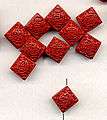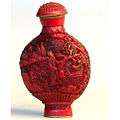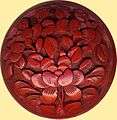Cinnebar
Cinnebar is a soft wood from the cinnebar tree, which grows in Southeast Asia.[1]
Uses
Because the cinnebar wood is very soft it can be used to create beads, boxes and accessories by pressing a pattern into the wood. Color is sometimes added with a resin to give it more stability.[1]
In Imperial China, lacquers were revered due to the time and superior craftsmanship required to produce items from cinnebar. The lacquer is created from the sap of a native Chinese tree, Rhus Verniciflua. The lacquering technique dates back 3,000 years and involves the application of up to 200 thin layers of processed sap. The sap produces a natural varnish that protects the wood. Carving the lacquer is equally arduous and is considered a true art.[2] The most popularly known use of cinnabar is in Chinese carved lacquerware, a technique that apparently originated in the Song Dynasty. The danger of mercury poisoning may be reduced in ancient lacquerware by entraining the powdered pigment in lacquer,[16] but could still pose an environmental hazard if the pieces were accidentally destroyed. In the modern jewelry industry, the toxic pigment is replaced by a resin-based polymer that approximates the appearance of pigmented lacquer.
Gallery
Items crafted from cinnebar.
References
- 1 2 Hand Carved Cinnebar, Jewelex.com, Retrieved on May 2, 2008
- ↑ Chinese Handicrafts, Cartage.org, Retrieved on May 8, 2008






